Vitamins and minerals are micronutrients required in small quantities in the body compared to macronutrients and are essential for many different functions. In the article: “All you need to know about Vitamins”, we discussed why vitamins are crucial and how much you should get with your diet. In this article, we’re going to take a closer look at the numerous and varied functions of minerals in the body. Minerals form components of co-enzymes, hormones, and vitamins. They are involved in tissue-building, forming part of the hard and soft structures of all the body’s tissues. Also, minerals are essential nutrients involved in many of the body’s regulatory functions, enabling energy production, growth, and healing. The minerals necessary to life can be classified as macro-minerals or microminerals. Macro-minerals are required in amounts greater than 100 milligrams per day, whereas microminerals, also known as trace minerals, are required in amounts less than 100 milligrams per day.
| Macro-minerals | Microminerals |
| Calcium Sodium Potassium Phosphorus Magnesium Sulphur | Iron Copper Zinc Selenium Fluoride Iodine Chromium Molybdenum Manganese |
Overview of minerals.
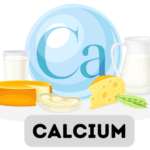
Let’s start by considering calcium, one of the human body’s most vital and abundant minerals. Calcium is needed to form and maintain the strength and density of bones and teeth. Calcium absorption and load-bearing exercise are necessary throughout life to maintain good bone density. If we do not optimise our bone density at a young age, we are more prone to brittle bones and osteoporosis when we are older. Calcium also plays an important role in blood clotting and nerve functioning.
Low calcium intake or failure to absorb calcium can lead to low bone density, osteoporosis, rickets and osteomalacia. Rickets is a softening in children’s bones, resulting in weak and deformed bone, and osteomalacia is like rickets but in adults. It is essential to know that we need vitamin D for calcium absorption. The hormone oestrogen also plays a vital role in maintaining optimum calcium status. Rich sources of calcium include milk, cheese, yoghurt and canned fish, but calcium can also be found in dark green leafy vegetables like spinach, broccoli, cabbage or celery, white flour, white bread, cereals, nuts, seeds, soya products such as tofu. The RNI for calcium varies according to age, gender, and certain medical conditions. To give you an idea, for most adults, the figure is set at 700 mg per day. Large calcium intake in susceptible people can lead to kidney stones. However, besides this group, the risk of calcium toxicity is minimal.
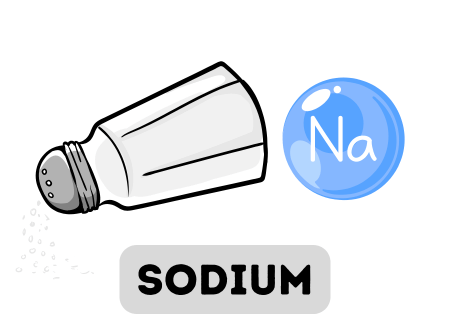
The leading role of sodium in the body is to assist in regulating the body’s water content by maintaining the extracellular fluid volume (ECF), which includes blood plasma and all fluids not contained within the cell itself. Sodium also works as part of nerve functioning. A deficiency of sodium can lead to fatigue, nausea, cramps, and strong thirst. Most of the sodium in the British diet comes from everyday foods such as bread, cheese, processed meats, and ready meals. The other main source is table salt (sodium chloride). The dietary reference value for sodium is 1,600 mg/day.
Current intakes are between 2 and 10 g/day. Recommendations state we should aim to consume no more than 6 g of salt per day, which is roughly one teaspoon.
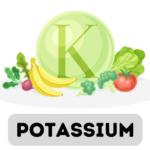
The following important mineral is potassium, essential for the normal functioning of our muscles, nerve cells and organs, including the heart, the kidneys and adrenal glands. It is involved with regulating water and fluid balance in the body with sodium and chloride. Research has shown that regular consumption of potassium-rich foods can help to lower and control blood pressure. In addition, it will allow us to store carbohydrates in the form of glycogen – the body’s primary and preferred energy source.
A lack of potassium can lead to muscle weakness, mental confusion, and heart failure (in extreme cases). Potassium can be found in most foods, mainly fruits and vegetables. It is essential to know that all unprocessed foods tend to have a higher potassium content. All meats and fish are good sources of potassium, as are soy products and vegetables, including broccoli, peas, lima beans, tomatoes, and potatoes. Bananas are one of the best sources of potassium. Other fruits that contain significant sources of potassium include citrus fruits and apricots.
The dietary reference value for potassium is 3,500 mg/day. Intakes above 17.6 g/day may be toxic and produce hyperkalaemia, where the levels of potassium in the blood are elevated above normal, causing symptoms such as palpitations and muscle weakness. This is a risk for the kidneys, especially if they are not functioning correctly. This level of intake is only possible if brought about by supplementation. Toxicity is unlikely if we have a usual dietary intake.
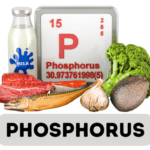
Phosphorus is another mineral found in every cell in the body. As an essential component of all cells, it is used in all energy pathways. About 80 percent of phosphorus in the body is found in the skeletal system of bones and teeth. The other 20 percent is found in the soft tissues as inorganic phosphate. Phosphorus is so readily available in the food supply that there is generally no deficiency. Excessively high levels of phosphorus in the blood are rare and can combine with calcium to form deposits in soft tissues such as muscle. High levels of phosphorus in the blood only occur in people with severe kidney disease or severe dysfunction of their calcium regulation.
Phosphorus is a significant component of all animal and plant cells and is in many food additives. Fruits and vegetables contain only small amounts of phosphorus. Good sources of phosphorus are meat, poultry and protein-rich foods, including milk, cheese, fish, and eggs. The RNI of phosphorous is the same as calcium’s when measured in mmol. Therefore, for most adults, this is 17.5 mmol per day. The maximum tolerable intake of phosphorus is set at 70 mg/kg body weight. This is well above anything you are likely to achieve through dietary intake; therefore, excessive intake is highly unlikely.
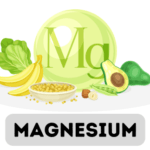
Magnesium plays a vital role in the formation and strengthening of bones and teeth and helps to manage the levels of calcium within the blood. It is involved in nerve and muscle function alongside potassium, sodium, and calcium, helping to relax nerves and muscles. Its role in muscle contraction is why it can be used medically to reduce irregular heart rhythms and muscle contractions. Magnesium also makes proteins within the body and helps blood circulate smoothly.
A long-term lack of magnesium can lead to hypomagnesaemia, a condition in which there is an abnormally low level of magnesium in the blood, with symptoms including weakness and muscle cramps. Hypomagnesaemia can be brought about by starvation, alcoholism, acute pancreatitis, or prolonged diarrhoea. Like all minerals, magnesium cannot be made in our body and must, therefore, be plentiful in our diet to remain healthy. Magnesium is found in many foods. Good sources include meat and animal products, wholegrain cereals, nuts and seeds–such as almonds, peanuts, pumpkin and sunflower seeds, spinach, broccoli, green beans, cucumber and celery.
The RNI for magnesium is 270 mg for men and 300 mg per day for women. If your kidneys are working normally (normal renal function), there is no evidence that large dietary intakes can be harmful. Excessively high circulating magnesium levels are almost impossible to achieve through normal dietary intake as the excess is excreted.
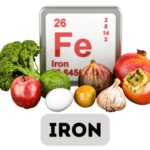
Let’s now look at iron, which is found in every human cell. Iron is an important component of haemoglobin and myoglobin and gives them their oxygen-carrying capability. In other words, it enhances oxygen distribution throughout our body. It is also an important component of many enzymes, helping to keep the immune system healthy and the body to produce energy. Iron is stored in the body as ferritin.
Iron deficiency can cause anaemia. Certain groups are more vulnerable to iron deficiency. This is either due to an increased need for iron not being met by dietary intakes, high loss of iron from the body, or poor absorption of dietary iron. Groups with increased iron needs include infants, toddlers, adolescents, pregnant women, people who drink a lot of tea, the elderly, people on high-fiber diets, and menstruating women.
Rich sources of iron include red meat and offal. Cereals, bread, flour, and vegetables also contain some iron. The iron that is found in meat (haem iron) is better absorbed by the body than the form found in plant sources. If you have a diet that is devoid of meat, you will require a higher intake of iron to compensate for lower absorption. Consuming a good source of vitamin C with your meals can enhance iron absorption. If you are vegetarian or vegan, you should plan meals to take this factor into account.
Dietary reference values depend on age and gender. As a guideline, the RNI for an adult (19 -50 years) female is 14.8 mg, and for a male, 8.7 mg. Dietary overload is rare in adults in the UK unless it is due to an inherited genetic disorder such as haemochromatosis. This condition leads to excessive absorption and storage of iron and cannot be prevented by dietary intervention alone. Some groups may have poor iron status. Take a moment to see the reasons why.
- Pregnancy. Pregnant women need more iron to prevent anaemia during pregnancy because the demand for iron and other vitamins is increased by the foetus and placenta needing their own supply of iron, which can only be obtained from the mother.
- Children. Infants, toddlers, and adolescents need more iron because of the increased demand for iron by the body to meet rapid tissue development.
- Tea. People who drink a lot of tea need an increase in iron because tea contains tannins that make it difficult for the body to absorb iron.
- Elderly people. The elderly need more iron because our ability to absorb iron from food declines with age.
- High-fibre diets. People on high-fibre diets need more iron because fibre impairs their ability to absorb iron from food.
- Menstruation. Menstruating women need an increase in iron because iron is lost during menstruation.
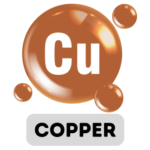
The following mineral is present in every body tissue but is stored primarily in the liver. Copper is a component of cytochrome oxidase and superoxide dismutase. These key enzymes form part of the body’s antioxidant defence system, reducing tissue damage by free radicals. Copper is also a component of many other enzymes and is essential for the metabolism of iron, helping your body to utilise iron.
Copper deficiency is most likely in infants, who may suffer from anaemia, skeletal fragility, and infections. Defects in cardiovascular function are seen in adults. Copper can be found naturally in liver, shellfish, whole grains, spinach, green beans, asparagus, squash, tomatoes, nuts—cashews—and seeds—sesame seeds and sunflower seeds.
The dietary reference value for copper in adults is 1.2 mg/day. High intakes of copper are toxic, but chronic copper ingestion has not been seen in the UK. Accidental ingestion of high levels of copper can cause vomiting and diarrhoea, and a build-up of copper can be fatal. Cases of copper toxicity have been reported in West Germany and the USA, where contaminated water was consumed.
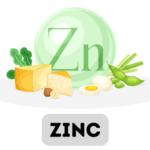
Zinc, like copper, is also present in all tissues. It is essential for growth, repair and sexual maturation. It is a necessary component of several enzymes, and it plays a regulatory, structural, or catalytic role in helping speed up chemical reactions. Zinc is involved in the major metabolic pathways that contribute to the metabolism of CHO, lipids, proteins, energy, and amino acids. It is also essential for us as it is an important antioxidant and, as such, is key to our body’s antioxidant defences.
A zinc dietary deficiency is quite rare, but it can lead to delayed puberty and retarded growth. Defects in rapidly dividing tissues, such as the immune system, skin, and intestinal mucosa, are also evidenced. Alcohol consumption increases the need for zinc as it is utilised in the enzyme alcohol dehydrogenase. This enzyme breaks down alcohol and metabolises it. The more alcohol consumed, the more this enzyme is produced in the body, and the more zinc is required.
Good sources of zinc include red meats, including beef, venison and lamb, offal, cereals, bread, flour, and vegetables – pumpkin, spinach, broccoli, greens, peas and asparagus. The average zinc intake is between 9 -12 mg/day, and the RNI is set at 9.5 mg and 7 mg per day for men and women, respectively. High intakes of zinc may interfere with both iron and copper metabolism. This can occur when water that has been consumed has been stored in galvanized containers. The typical symptoms include vomiting, nausea, and fever. Acute ingestion of about 2 g of zinc or more could bring on these symptoms.

Selenium is an essential ingredient of the enzyme glutathione peroxidase, an important part of the body’s antioxidant defence system. This enzyme protects the cell structure against the harmful effects of oxidative and free-radical damage. A deficiency has been proposed to be contributory to the occurrence of cancer and coronary heart disease. Fruit, vegetables, and cereals can be rich in selenium, but this is dependent on the selenium content of the soil in which they are grown. Meat, fish, eggs and Brazil nuts are also good sources.
The dietary reference value for adults is 75 μg/day and 60 μg/day in men and women respectively. Intakes above 750 μg/day have been known to disturb the body’s preferred selenium balance, and intakes above 900 μg/day have resulted in nail dystrophy (poor nail growth).
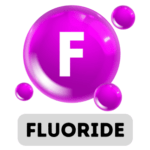
Fluoride is one of the micro or trace minerals. 99 percent of the body’s fluoride is found within bone and teeth where it is needed to increase strength through increasing tooth mineralisation and bone density and is needed also reduce the risk of tooth decay. A deficiency of fluoride can contribute to poor dental health and may lead to increased cavities, and weak bones and teeth. Fluoride has long been added to drinking water on evidence that it reduces tooth cavities in children and helps strengthen bones. Too much fluoride in the diet is very rare.
Fluoride is found in varying concentrations in tap water and is often added by many water companies in areas where natural fluoride levels are low because of the strong evidence to show how it helps prevent tooth decay. Other primary dietary sources are tea and seafood. No RNI exists for fluoride, as there is no physiological requirement for it. An excessive intake of fluoride can cause dental fluorosis. This can range from mild mottling on the teeth to severe fluorosis, where the tooth enamel becomes pitted and widespread brown staining of the teeth is evidenced. This is rare but has been seen in the UK with children who swallow toothpaste.
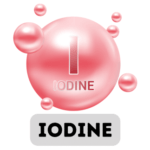
Iodine is a trace element found in seawater, rocks, and some soil types. Iodine forms an intrinsic part of the hormones thyroxine and triiodothyronine. These two hormones are the major contributors to controlling the body’s metabolic rate. They also play a role in connective tissue integrity and cellular metabolism. During the first three months of gestation, iodine is necessary to develop the foetus’s nervous system. Should an infant be deprived of iodine during pregnancy, then it is liable to suffer from a condition known as cretinism, causing dwarfism and mental retardation. However, this type of deficiency is now very rare in the UK.
Good sources of iodine in the diet include milk, which is a major source in the UK diet, yoghurt, and eggs. Seafoods are good sources, and some dried seaweed is a particularly rich source. Some sea fish, such as cod, sea bass, haddock, and perch, are good sources and may contain as much as 1,200 μg/kg.
The RNI for iodine is 140 μg/day. Although iodine can be toxic at very high levels, very few cases of toxicity are seen where intakes of iodine are below 5,000 μg/day. High intakes can cause toxic nodular goitre (a swelling of the neck due to enlargement of the thyroid gland) and hyperthyroidism (overactivity of the thyroid gland, brought about by its enlargement). High intakes would be in the range of 10-20 mg/day.

Chromium is a micro (or trace) mineral that helps maintain insulin levels. Insulin is the hormone that helps regulate blood glucose (sugar) levels, by allowing the hormone to move sugar into the body cells, where it is needed to produce energy. Deficiency in humans is rare except in people who have had long-term intravenous feeding. Studies are being undertaken to discover whether chromium supplementation may benefit people with diabetes. The results of this research are inconclusive.
Although chromium occurs naturally in a wide variety of foods, many foods contain only small amounts. In addition, food processing methods often remove the chromium. Good sources of chromium include brewers’ yeast, meat especially liver, nuts, legumes and whole grains, bran cereals and potatoes. The more highly refined a food, the less its chromium content is likely to be. Although no RNIs have been set, an intake of above 25 μg/day for adults is considered adequate to ensure chromium plays a role in the body’s use of energy-providing carbohydrates, protein, and fat.
Other minerals
In this article I tried to cover all the major minerals that are needed in everyday nutrition. Of course, there are other minerals found in food that the body requires in small amounts which are essential for your good health. The list shown below is of some of the less well-known minerals which also have a role to play and are necessary for the healthy functioning of the body’s systems, from bone growth to brain function.
| Molybdenum | Cadmium | Nickel |
| Manganese | Caesium | Silicon |
| Aluminium | Cobalt | Silver |
| Arsenic | Germanium | Strontium |
| Antimony | Lead | Vanadium |
| Boron | Lithium | Sulphur |
| Bromine | Mercury |
To decide on vitamin and mineral supplementation, you’ll need a good understanding of what they are and why you need them. My article “The basics of vitamins and minerals in your diet, and why are they so important” provides a detailed list of the sources of vitamins and minerals.




